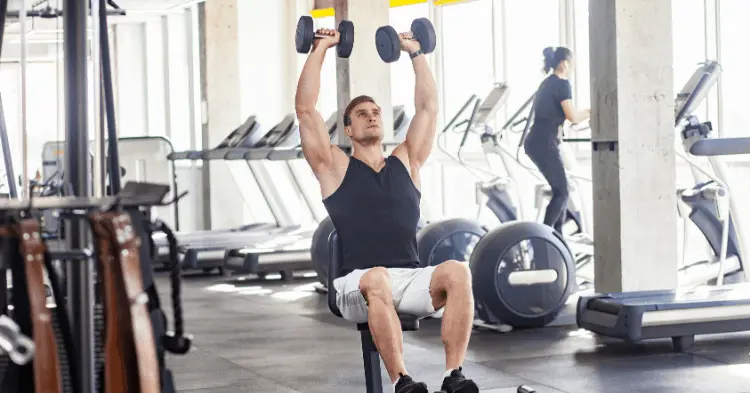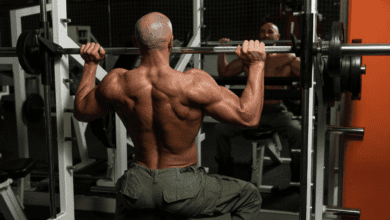How to Do the Arnold Press Exercise Techniques Benefits Variations
arnold press exercise

The Arnold Press exercise is a popular shoulder exercise amongst gym-goers. And yes, it’s created by and named after the big man himself. This exercise doesn’t only have inspiring origins. It comes complete with a nice list of benefits too.
If you’re keen to explore this versatile exercise and what it can do for you, you’re in the right place. Arnold Press Exercise benefits, technique tips, variations and FAQs – coming right up!
What Muscles Does Arnold Press Exercise Work?
The Arnold Press Exercise is a shoulder exercise. But it is unique from a lot of the other shoulder exercises that exist. Why? Because it targets all three of your deltoid muscles, as opposed to just one or two of them.
This compound exercise works your anterior, medial and posterior deltoids as primary muscles. Your traps and pecs will also chip in, as will your triceps, as secondary muscles. If you’re seeking full and rounded shoulders, this exercise is a great addition to your workouts!
Benefits of Arnold Press
Below you will find several Arnold Press Exercise benefits, which make it easy to see why it is a much-loved exercise.
1. Encourages Lean Mass Development
When performing this exercise, your shoulders spend a lot of time under tension. Compared to other shoulder exercises, the time spent under tension is far superior.
Studies have shown a link between time under tension and the development of lean mass. Combined with the fact that this press hits all your deltoids, it’s a good option for mass building.
2. Increases Shoulder Stability
One of the most unique things about the Arnold Press Exercise is its mid-lift twist. This rotational movement means your stabilizer muscles get put to work. Consistent practice of this exercise can improve your shoulder stability over time.
This exercise requires your shoulder joint to rotate under load. Because of this, you need some existing shoulder stability to do the Arnold Press Exercise safely.
It’s also worth mentioning at this point that there is a standing version of the Arnold Press too. Your core stabilizers work hard as you press the weight overhead. So, it’s safe to say that this exercise will increase your core stability too!
3. Improves Posture
A lesser-known Arnold Press Exercise benefit is that it assists in improving your posture.
It does this by restoring structural balance through your shoulders. As mentioned before, this exercise targets all three of your deltoid muscles. Having proportionally balanced strength and mass is a giant step towards great posture.
The Arnold Press Exercise is one of the rare exercises that hits your rear-deltoids. Our rear-deltoids are partially responsible for pulling our shoulders back into position, as are some of our smaller sub-scapular muscles that also get put to work in this exercise.
4. Maintains & Increases Shoulder Mobility
A wide range of movement exists in the Arnold Press Exercise, compared to other shoulder exercises. This is because it includes a rotation through your shoulder joints as well as an overhead press. This assists in keeping your shoulder joints moving without restriction.
To do this exercise, you do need an existing level of shoulder mobility. Otherwise, you run the risk of injury. If existing shoulder mobility is there, the Arnold Press Exercise is one great way to help enhance and maintain it.
5. Builds Strength
The benefits mentioned above are all contributors to your ability to gain strength. Thus, strength gains are another benefit of the Arnold Press Exercise. Of course, no exercise alone will be the answer to the body of your dreams. But, a combination of the right ones will get you there quicker.
If building strength through your shoulders is on your to-do-list, this exercise can be a good one for you.
How To Do the Arnold Press
To reap the benefits of any exercise, how you perform it is key. And usually, there is only one right way – which helps simplify things! Shoulders are a hot spot for injuries. And most of them come down to poorly performed exercises.
To do the Arnold Press (traditional seated Arnold Press), follow these steps:
- Sit on a bench.
- Have a dumbbell in each hand at the top of a bicep curl position so that your palms are facing you.
- Push the weights up overhead while twisting the dumbbells 180-degrees. Finish in an overhead press with your palms facing away from you.
- Slowly bring the weights back down to their original position, with your palms facing you.
PRO TIP: On the way back to starting position, stop when your upper arm is parallel to the ground. Make that your endpoint. Hold there for a second, and then push back up into your next repetition. This further increases the time your deltoids spend under tension.
The Variations
If you’re a fan of the Arnold Press Exercise, you’ll be glad to know there are a few interesting variations to keep you busy.
Standing Arnold Press
The next logical step after mastering the seated Arnold Press would be to give the standing one a go. Same thing movement-wise, but with more stabilizing demands on your core.
As you push the dumbbells overhead, you’ll need to recruit your core to stabilize your spine. A good way to do this is to tuck your hips underneath you and squeeze your glutes. And don’t forget to brace your stomach as if you are soon to be on the receiving end of a punch.
Single-Arm Kettlebell Arnold Press
This variation is best-done standing. One of the main challenges of this exercise is the amount of stabilization it requires. By performing it seated, you’re missing out on half of the work.
Start with the kettlebell in a rack position. Your other arm can be out wide to your side, to assist with balance. Make a 180-degree rotation as you push the kettlebell up overhead. This version of the Arnold Press will get your obliques, abs and glutes fired up, as well as your shoulders.
Half-Kneeling Single-Arm Arnold Press
This variation is excellent for building balanced strength and mass through your shoulders. As it’s not seated, and rather in a half-kneeling position, it also requires your core to get involved.
To perform this exercise, go into a half-kneeling position with a dumbbell in one hand. Should you be starting with your left arm, then you should be kneeling on your left knee.
Tucking your hips underneath, you will encourage a neutral spine. Avoid leaning back through your thoracic as you push the dumbbell overhead. This shifts the load of the press from your shoulders to your chest.
FAQs About The Arnold Press
So now you know, what an Arnold Press is, what muscles it works, what its benefits are, and how to do it! But perhaps you have a few questions about this exercise that remain unanswered?
Fear not – this FAQ’s section covers some of the most asked questions about the Arnold Press.
How much weight should I use?
Due to the range of movement and time under tension in the Arnold Press, it’s best to do it with lighter weights. This especially true for those who are only starting with this exercise. Start light to perfect your form, and then move onto something manageable.
Having said this, you should align the weight you use with your training goals too.
How many repetitions should I do?
Again, due to the demands of this exercise, it is best done over more repetitions using less weight. Between 10 to 12 repetitions would be a reasonable starting place.
Of course, you can do fewer repetitions if you’re using a heavier weight. But the Arnold Press Exercise is typically done with light weights and higher reps.
Is doing the Arnold Press bad for your shoulders?
If you’re free of existing shoulder injuries and have good mobility, there is no reason why this exercise is bad for your shoulders.
If you feel shoulder pain while doing the Arnold Press Exercise, assess your technique first. If it’s your mobility that is holding you back, then work on it and revisit this exercise a little later down the track.
Is the Arnold Press better than a Shoulder Press?
The reality is it depends on who you ask. There is no one-size-fits-all when it comes to exercises. Where some may swear by the shoulder press, others may be fiercely loyal to the Arnold Press.
The Shoulder Press works your anterior deltoids hard. Harder than the Arnold Press does. The Shoulder Press doesn’t deliver the amount of posterior and medial delt attention that the Arnold Press Exercise does, though.
At the end of the day, it comes down to your training goals and what other exercises you include in your regime.
If you’re wondering which is more of an ‘all-encompassing’ shoulder exercise? Then yes, the Arnold Press Exercise takes the cake.
Closing Words
Who doesn’t love training shoulders? And with exercises as great as the Arnold Press, what’s not to love? As you can see, this exercise is a goodie because it works your whole shoulder. Each deltoid muscle gets put through their paces, delivering an array of benefits.
You know the drill! If we’ve left out a variation you would like to share with our readers, mention it in the comments section below!
If you found this blog helpful, then do share it with your friends and on social media so that more people can get the information.
For the latest news and updates please follow us on Instagram.




